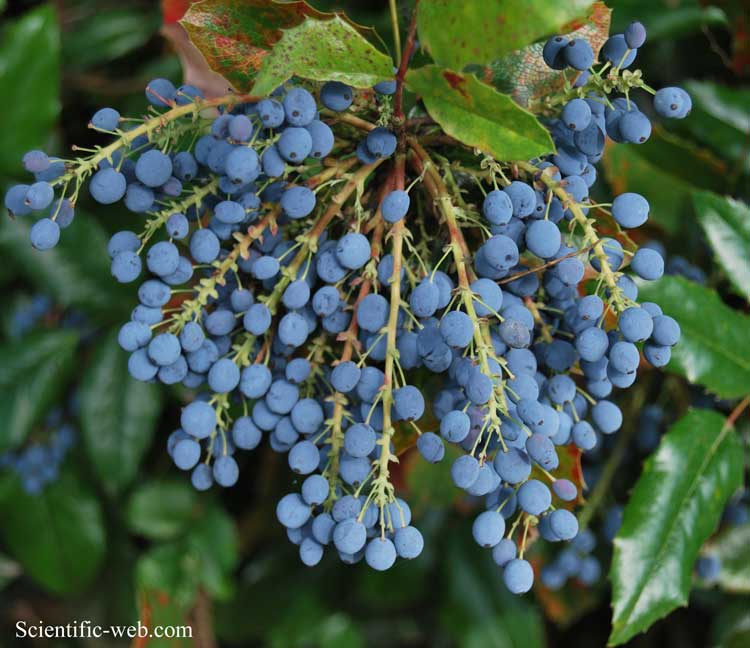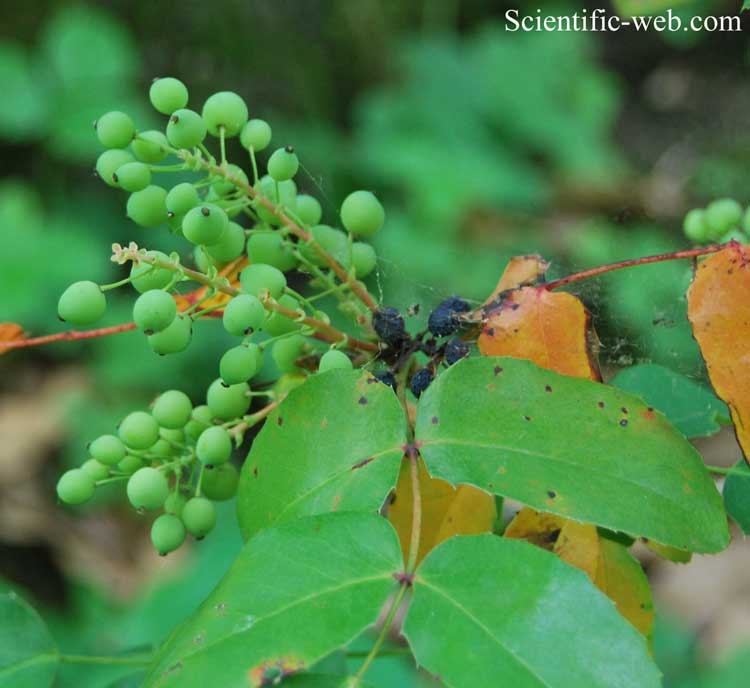
Berberis aquifolium, Photo: Michael Lahanas
Classification System: APG IV
Superregnum: Eukaryota
Regnum: Plantae
Cladus: Angiosperms
Cladus: Eudicots
Ordo: Ranunculales
Familia: Berberidaceae
Subfamilia: Berberidoideae
Genus: Berberis
Species: Berberis aquifolium
Name
Berberis aquifolium Pursh
Synonyms
Berberis aquifolium var. lyallii (Ahrendt) J. S. Marroquin & J. E. Laferriere
Berberis aquifolium var. nutkana (DC.) J. S. Marroquin & J. E. Laferriere
Berberis pinnata Banks ex DC.
Berberis piperiana (Abrams) Mc Minn
Mahonia aquifolium (Pursh) Nutt.
Mahonia aquifolium var. lyallii Ahrendt
Mahonia aquifolium var. nutkana DC.
Mahonia diversifolia Sweet
Mahonia fascicularis DC.
Mahonia latifolia Hort. ex Dippel
Mahonia moseriana Moser ex H. Martinet
Mahonia murrayana Hort. ex Dippel
Mahonia piperiana Abrams
Odostemon aquifolium (Pursh) Rydb.
Odostemon fascicularis Abrams
Distribution
Native distribution areas:

Berberis aquifolium, Photo: Michael Lahanas
References
Ruprecht, F.J.I. (1813-1814). Flora Americae Septentrionalis 1: 219, t. 4 .
Links
Hassler, M. 2019. Berberis aquifolium. World Plants: Synonymic Checklists of the Vascular Plants of the World In: Roskovh, Y., Abucay, L., Orrell, T., Nicolson, D., Bailly, N., Kirk, P., Bourgoin, T., DeWalt, R.E., Decock, W., De Wever, A., Nieukerken, E. van, Zarucchi, J. & Penev, L., eds. 2019. Species 2000 & ITIS Catalogue of Life. Published on the internet. Accessed: 2019 Apr. 19. Reference page.
International Plant Names Index. 2019. Berberis aquifolium. Published online. Accessed: Apr. 19 2019.
The Plant List 2013. Berberis aquifolium in The Plant List Version 1.1. Published on the internet. Accessed: 2019 Apr. 19.
Tropicos.org 2019. Berberis aquifolium. Missouri Botanical Garden. Published on the internet. Accessed: 2019 Apr. 19.
USDA, ARS, Germplasm Resources Information Network. Berberis aquifolium in the Germplasm Resources Information Network (GRIN), U.S. Department of Agriculture Agricultural Research Service.
Vernacular names
čeština: mahonie cesmínolistá
Deutsch: Gewöhnliche Mahonie
English: Oregon grape
suomi: Mahonia, lännenmahonia
français: Mahonia faux houx
magyar: Közönséges mahónia, kerti mahónia
lietuvių: Dyglialapė mahonija
polski: mahonia pospolita
русский: Маго́ния падуболи́стная
Mahonia aquifolium, the Oregon grape or holly-leaved barberry, is a species of flowering plant in the family Berberidaceae, native to western North America. It is an evergreen shrub growing 1 m (3 ft) to 3 m (10 ft)[4] tall by 1.5 m (5 ft) wide, with pinnate leaves consisting of spiny leaflets, and dense clusters of yellow flowers in early spring, followed by dark bluish-black berries.[5]
Etymology
The Latin specific epithet aquifolium denotes "sharp-leafed" (as in Ilex aquifolium, the common holly), referring to the spiny foliage.[6]
Mahonia aquifolium is not closely related to either the true holly (Ilex aquifolium) or the true grape (Genus: Vitis).
Description
Mahonia aquifolium grows to 1–2 m (3 ft 3 in – 6 ft 7 in) tall by 1.5 m (5 ft) wide, with pinnate leaves up to 30 cm (12 in) long, each leaf made up of spiny leaflets. The leathery leaves resemble those of holly and the stems and twigs have a thickened, corky appearance. The flowers, borne in dense clusters in late spring, are yellow, and are followed by spherical dark dusty blue berries, which give rise to the common name "Oregon grape".[7]
Taxonomy
Some authors place Mahonia in the barberry genus, Berberis.[8][9][10][11] The Oregon-grape is not related to true grapes, but gets its name from the purple clusters of berries whose color and slightly dusted appearance are reminiscent of grapes.
The yellow flowers are in a raceme 3–8 cm long. Bombus species and other insects pollinate the flowers.
Each of the six stamens, opposite the petals, terminates in two spreading branches. The six bright yellow petals are enclosed by six bright yellow sepals. At the base of the flower are three greenish-yellow bracts. Less than half as long as the sepals, only one is partially visible.
Distribution
Mahonia aquifolium is a native plant in the North American West from Southeast Alaska to Northern California, and eastern Alberta to central New Mexico, often occurring in the understory of Douglas fir forests (although other forest types contain the species) and in brushlands in the Cascades, Rockies, and northern Sierras.
In some areas outside its native range, M. aquifolium has been classified as an invasive exotic species that may displace native vegetation.[12][13]
Cultivation
Mahonia aquifolium is a popular subject in shady or woodland plantings. It is valued for its striking foliage and flowers, which often appear before those of other shrubs. It is resistant to summer drought, tolerates poor soils, and does not create excessive leaf litter. Its berries attract birds.[5]
Numerous cultivars and hybrids have been developed, of which the following have gained the Royal Horticultural Society's Award of Garden Merit:[14]
M. × wagneri 'Pinnacle'[15] (M. aquifolium × M. pinnata)
'Apollo'[16]
Uses
The small purplish-black fruits, which are quite tart and contain large seeds, are included in small quantities in the traditional diets of Pacific Northwest indigenous peoples, mixed with salal or another sweeter fruit. Today, they are sometimes used to make jelly, alone or mixed with salal.[17] Oregon-grape juice can be fermented to make wine, similar to European barberry wine folk traditions, although it requires an unusually high amount of sugar.[18] The berries can also be eaten raw[19] after the season's first frosts.[20]
Herbal medicine
Some Indigenous peoples of the Northwest Plateau use Oregon grape for indigestion.[21]
Chemical constituents
Mahonia aquifolium contains 5'-methoxyhydnocarpin (5'-MHC), a multidrug resistance pump inhibitor, which works to decrease bacterial resistance in vitro.[22]
Culture
Oregon-grape is the state flower of Oregon.[23]
Diseases
As with some Berberis, × Mahoberberis, and other Mahoniae spp., M. aquifolium can serve as an alternate host for Puccinia striiformis f. sp. tritici. (The primary host of Pst being wheat.) However in this case it was only achieved by intentional inoculation in a lab, and it remains unknown whether this naturally occurs.[24]
References
Tropicos
The Plant List
Flora of North America vol 3
"Landscape Plants: Mahonia aquifolium". Oregon State University: College of Agricultural Sciences - Department of Horticulture. Oregon State University. Retrieved 4 July 2020.
RHS A-Z encyclopedia of garden plants. United Kingdom: Dorling Kindersley. 2008. p. 1136. ISBN 978-1-4053-3296-5.
Harrison, Lorraine (2012). RHS Latin for gardeners. United Kingdom: Mitchell Beazley. p. 224. ISBN 978-1-84533-731-5.
Michael P. Williams (2012). "Berberis aquifolium, in Jepson Flora Project (eds.) Jepson eFlora". Retrieved 2013-08-08.
Flora of North America, vol 3
Loconte, H., & J. R. Estes. 1989. Phylogenetic systematics of Berberidaceae and Ranunculales (Magnoliidae). Systematic Botany 14:565-579.
Marroquín, Jorge S., & Joseph E. Laferrière. 1997. Transfer of specific and infraspecific taxa from Mahonia to Berberis. Journal of the Arizona-Nevada Academy of Science 30(1):53-55.
Laferrière, Joseph E. 1997. Transfer of specific and infraspecific taxa from Mahonia to Berberis. Bot. Zhurn. 82(9):96-99.
"North Carolina Botanical Garden / Conservation / Plants to Avoid in the Southeastern United States". Archived from the original on 2011-10-19. Retrieved 2007-05-13.
Plants to Avoid in the Southeastern United States Tennessee Invasive Exotic Plant List
"AGM Plants - Ornamental" (PDF). Royal Horticultural Society. July 2017. p. 62. Retrieved 25 March 2018.
"RHS Plant Selector - Mahonia × wagneri 'Pinnacle'". Retrieved 13 April 2015.
"RHS Plant Selector - Mahonia aquifolium 'Apollo'". Retrieved 13 April 2015.
Pojar, Jim; MacKinnon, Andy, eds. (1994). Plants of Coastal British Columbia: including Washington, Oregon & Alaska, rev. ed. Vancouver: Lone Pine Publishing. p. 95. ISBN 978-1-55105-532-9.
Henderson, Robert K. (2000). The Neighbourhood Forager. Toronto, Ontario: Key Porter Books. p. 111. ISBN 1-55263-306-3.
Benoliel, Doug (2011). Northwest Foraging: The Classic Guide to Edible Plants of the Pacific Northwest (Rev. and updated ed.). Seattle, WA: Skipstone. p. 119. ISBN 978-1-59485-366-1. OCLC 668195076.
Lyons, C. P. (1956). Trees, Shrubs and Flowers to Know in Washington (1st ed.). Canada: J. M. Dent & Sons. p. 196.
Hunn, Eugene S. (1990). Nch'i-Wana, "The Big River": Mid-Columbia Indians and Their Land. University of Washington Press. p. 352. ISBN 0-295-97119-3.
Stermitz FR, Lorenz P, Tawara JN, Zenewicz LA, Lewis K (February 2000). "Synergy in a medicinal plant: antimicrobial action of berberine potentiated by 5'-methoxyhydnocarpin, a multidrug pump inhibitor". Proc. Natl. Acad. Sci. U.S.A. 97 (4): 1433–7. Bibcode:2000PNAS...97.1433S. doi:10.1073/pnas.030540597. PMC 26451. PMID 10677479.
"State Symbols: Dance to Hops - Flower, State". Oregon Blue Book. Oregon Secretary of State. 2021. Retrieved 10 May 2021.
Wang, M. N.; Chen, X. M. (2013). "First Report of Oregon Grape (Mahonia aquifolium) as an Alternate Host for the Wheat Stripe Rust Pathogen (Puccinia striiformis f. sp. tritici) Under Artificial Inoculation". Plant Disease. American Phytopathological Society. 97 (6): 839. doi:10.1094/pdis-09-12-0864-pdn. ISSN 0191-2917. PMID 30722629. S2CID 73433566.
Retrieved from "http://en.wikipedia.org/"
All text is available under the terms of the GNU Free Documentation License

